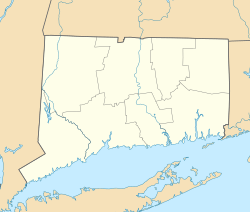Shippan facts for kids
Quick facts for kids
Shippan
|
|
|---|---|
| Country | United States |
| State | Connecticut |
| County | Fairfield County |
| City | Stamford |
Shippan is a neighborhood in the city of Stamford, Connecticut. It is located right along the Long Island Sound, which is a large body of water.
Contents
Shippan's Past: From Farms to Fun
Before the late 1800s, the area we now call Shippan was mostly covered in farms. Around that time, a part of Shippan called Shippan Point became a popular spot for wealthy people from New York City to spend their summers.
Sailing became a favorite activity for these visitors. Because of this, two yacht clubs were started: the Stamford Yacht Club and the Halloween Yacht Club.
Exploring Shippan's Geography
Shippan is a neighborhood, so its exact borders are not always clear. The city of Stamford often defines Shippan as mainly the Shippan Point peninsula. A peninsula is a piece of land almost surrounded by water, sticking out into the Long Island Sound.
However, some people who live there and local reporters also include areas north of Shippan Point as part of Shippan.
What's Around Shippan?
Shippan has several neighbors:
- To the west is the South End.
- To the north is Downtown.
- To the northeast is the East Side.
- To the east is The Cove.
The area south of where Shippan Avenue and Magee Avenue meet is known as the Shippan Point neighborhood. North of Shippan, the Metro-North train tracks and Interstate 95 separate it from Downtown Stamford.
Most of Shippan Point has homes for one or two families. The main streets in Shippan are Shippan Avenue and Elm Street.
Who Lives in Shippan?
Shippan is a neighborhood with many different kinds of people. It is home to many working-class families. However, the Shippan Point area is known for being wealthier and having a more similar group of residents.
Shippan's Local Economy and Places to Visit
Shippan has many different types of businesses. You can find Asian Indian stores and Italian pizzerias on Cove Road. There are also European delis on Elm Street.
The neighborhood also has some important places:
- Cummings Park is a public beach where people can relax and swim.
- St. Mary Roman Catholic Church and St. Benedict Roman Catholic Church are local churches.
- There is a supermarket, many restaurants, and small shops.
A Clairol factory used to be located where Shippan meets The Cove section, on Cove Avenue. In 2008, Clairol announced they would sell the factory. By 2011, the old factory was torn down. In its place, new buildings were built for an NBC Sports studio and the Chelsea Piers Stamford athletic and aquatic club.
The Water Treatment Plant
Shippan is home to the Water Pollution Control Authority. This is a sewage treatment plant that cleans wastewater. It also helps clean water for the nearby town of Darien. The plant is located on Magee Avenue, near the East Branch of Stamford Harbor.
The plant was first built in 1974. It could clean about 17 million US gallons (64,000 cubic meters) of water each day. In 2005, the plant was updated for $105 million. This upgrade increased its cleaning ability to 24 million US gallons (91,000 cubic meters) per day. It can handle a maximum of 68 million US gallons (260,000 cubic meters) on very busy days.
The city started removing nitrogen from sewage in 1988. The 2005 upgrade improved this, removing 90 percent of nitrogen, up from 65 percent. The upgrade also added three special machines to control odors, costing $6 million. These machines use chemicals to remove almost all of the bad smells. An ultraviolet light machine also cleans the water, so large amounts of chlorine are not needed.
This plant is a big landmark in the neighborhood. In the past, some residents had complained about smells coming from it.


